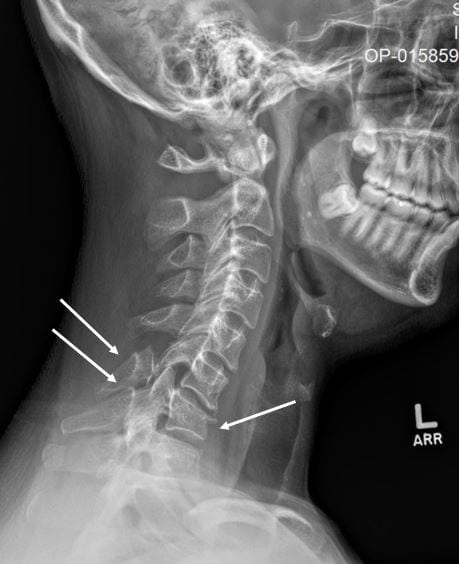Published on
Differential Diagnosis
- Acute cervical strain
- Spinous process fracture
- Vertebral artery dissection
- Spinal stenosis

Diagnosis
This patient was diagnosed with a fracture of the C6 spinous process, a fracture of the C7 vertebral body, and perched facets. This indicates an injury passing through all columns of the cervical spine secondary to severe flexion motion. Findings include kyphosis at C6-7, downward displacement of the C6 spinous process (increased interspinous distance), perched appearance of the posterior facets of C6 on C7, and anterior wedging of the C7 vertebral body with adjacent prevertebral soft tissue swelling.
Learnings/What to Look for
- Signs of cervical spine fracture instability include increased or reduced intervertebral disc space height, increased interspinous distance, facet joint widening, vertebral compression >25%, and more than one vertebral column involvement
- Flexion teardrop fractures most commonly occur at mid/lower cervical spine
- The most characteristic findings include:
- fracture of the anteroinferior lip of vertebral body—classic triangular fragment (teardrop sign)
- larger fragments may not appear triangular, anterior fragment often minimally displaced
- posterior displacement of the posterior vertebral body relative to the intact inferior cervical column
- Abnormal spinal alignment is often less apparent if imaging occurs after traction is performed
- Intervertebral disc space narrowing (discoligamentous injury) is more common
Pearls for Urgent Care Management
- Patients with such fractures require immobilization and additional imaging with MRI
- Conservative treatment is analgesics, restriction of physical activity, and a soft cervical collar for 4–6 weeks
- Surgical treatment may be necessary to stabilize injury and/or remediate chronic pain
Acknowledgment: Image and case presented by Experity Teleradiology (www.experityhealth.com/teleradiology).
A 35-Year-Old with Neck Pain After an Auto Accident
1 2
